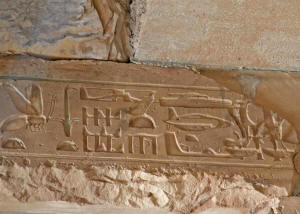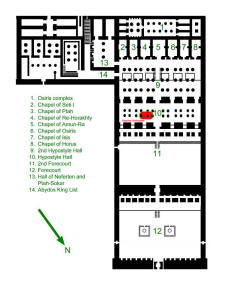'In April this year
the Internet began to buzz with rumours of an amazing
helicopter-like hieroglyph, which had been discovered on a wall
panel in the Egyptian temple of Seti I at Abydos.... I
can now confirm that this hieroglyphic wall panel does exist and
I have in my possession the negatives to prove it.
By a strange twist of fate, I was already planning a research
trip to Egypt at the time this remarkable find was announced,
and furthermore I was intending to visit the very same temple in
Abydos to check out another mysterious anomaly - a megalithic
structure known as the Osirieon. So I decided to take the
opportunity to check whether the alleged helicopter existed or
not...

And so it was that
in early June, my wife and I arrived at the temple of King
Seti I. Having swiftly passed through the courtyard, we
entered the First Hypostyle Hall. As I casually glanced
up, I saw to my astonishment that the roof beam bearing the
'helicopter' image was right there, immediately inside the
entrance on the left hand side, at a height of about 8
meters!... The most impressive aspect of the 'helicopter' is the
combination of rotor blade, rotor shaft and tail-piece, the
relative positions of which bear a close resemblance to modern
helicopters, with cockpit and fuselage sections clearly visible.
Alongside the "helicopter", to its right, another strange object
can be seen, resembling a tank with a turret. And beneath the
"tank" is a hieroglyph which some have compared to a submarine
or aircraft, with a pronounced fin at one end.

What is the opinion
of the Egyptologists? The consensus is that there is no mystery
about this wall panel, which is simply a re-carved inscription
of a royal name. But whilst it may be true that King Ramesses II
overlaid the panel of his predecessor King Seti I with
his own inscription, this does not explain why there is a
helicopter-like hieroglyph. This standard response of the
Egyptologists seems to be ducking the issue...
Taken as a whole, this frieze at Abydos conjures up the
impression of a parade of military hardware. Indeed, the central
section, including the 'submarine', has been translated by one
Egyptologist as meaning,
'He who
represses the nine bows (i.e. foreign countries).'
It seems that it is
highly significant to find a shape identical to a modern
helicopter, alongside at least one other anomalous image, in the
context of what seems to be a war-panel.
Now I am not for one minute suggesting that helicopters were
flying in Egypt at the time of King Seti I three thousand
years ago. If that was so, we would find numerous such
representations all over Egypt, because this is a period from
which a great deal of Egyptian art and architecture has
survived. But there are none...
Could the helicopter-like image be an archaic image of a real
flying machine at the beginning of Egyptian history, which
has been copied and recopied countless times?'
(Extracts
from 'Ancient Helicopter is not a Hoax', an article in UFO
Magazine, UK, Sept/Oct 1997, pp. 19-21)
'Egypt, too, has a famous example of ancient flight capability
at the 3,000-year old temple of Seti I in Abydos, where
an amazingly helicopter-like device graces the stone roof beam
just inside the entrance. As a result of archaic images such as
this one, Egyptologists have labelled the Abydos temple 'a
regular antique gallery', but they have been unable to offer any
convincing translation of the hieroglyphic 'helicopter', which I
personally viewed in 1997.
Its presence at this
period of Egyptian history seems most unlikely, but we must bear
in mind that the temple of Seti I is almost certainly a
reconstruction of a much older temple, possibly dating back to
4000 BC.'
(The
Phoenix Solution pp. 391-92)
'Did the pre-dynastic Egyptians inherit a legacy of ancient
aeronautical flight? The idea seems far-fetched, but so does
the technology in the Great Pyramid of Giza, and the
existence of the Pyramid cannot be challenged!'
(The Phoenix
Solution p. 392)